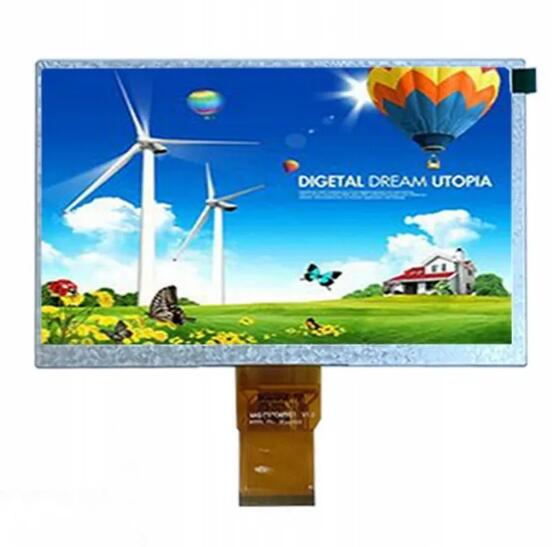In-Depth Analysis of Input Data Interfaces for TFT LCD Modules
2024-07-25
Introduction
The evolution of TFT (Thin Film Transistor) LCD (Liquid Crystal Display) modules has revolutionized the display industry, enabling high-resolution, vibrant screens across various devices. The efficiency and performance of these modules are heavily influenced by the input data interfaces used. In this blog, we delve deeper into the technical aspects of the most common input data interface types for TFT LCD modules, examining their characteristics, benefits, and applications.
Parallel RGB Interface
Technical Overview:
The Parallel RGB interface transmits color data (Red, Green, and Blue) along with synchronization signals (HSYNC and VSYNC) in parallel. Typically, this interface uses 18, 24, or 30 data lines to deliver pixel information to the display.
Characteristics:
- High Data Transfer Rate: The parallel transmission allows for high-speed data transfer, which is essential for high-resolution displays.
- Signal Integrity: Requires careful management of signal timing and integrity, as multiple lines can be susceptible to noise and crosstalk.
- Power Consumption: The multitude of data lines increases power consumption, making it less suitable for battery-powered devices.
- Complex PCB Design: The large number of connections can complicate PCB layout and increase design costs.
Applications:
- High-Resolution Monitors: Ideal for desktop monitors and gaming displays where high data rates are crucial.
- Industrial Equipment: Used in control panels and medical devices that require fast and precise display updates.
LVDS (Low Voltage Differential Signaling)
Technical Overview:
LVDS transmits data differentially, reducing electromagnetic interference and enabling high-speed communication over longer distances with fewer wires compared to parallel interfaces.
Characteristics:
- High Speed and Low EMI: Supports high-speed data transfer with minimal electromagnetic interference, ideal for environments sensitive to noise.
- Low Power Consumption: Differential signaling reduces power usage, beneficial for devices requiring energy efficiency.
- Reduced Pin Count: Fewer data lines simplify the PCB design and reduce manufacturing complexity.
- Long-Distance Communication: Suitable for applications needing data transmission over extended distances without significant signal degradation.
Applications:
- Automotive Displays: Used in infotainment systems and digital dashboards where low EMI and long cable runs are required.
- Laptops and Monitors: Common in high-resolution laptop screens and external monitors.
MIPI (Mobile Industry Processor Interface)
Technical Overview:
MIPI DSI (Display Serial Interface) is a serial communication protocol designed for mobile devices. It utilizes a high-speed, low-power serial link to transmit display data.
Characteristics:
- High-Speed Data Transfer: Capable of supporting high-resolution and high-refresh-rate displays, making it suitable for advanced graphics.
- Power Efficiency: The serial nature of the interface reduces power consumption, which is crucial for mobile and portable devices.
- Compact and Simplified Design: Fewer signal lines reduce the complexity of PCB layout, allowing for more compact designs.
- Scalability: Easily scalable for different resolutions and display sizes, offering flexibility in design.
Applications:
- Smartphones and Tablets: Standard in mobile devices, providing high-speed and power-efficient data transfer.
- Wearable Devices: Ideal for smartwatches and fitness trackers where space and battery life are critical.
SPI (Serial Peripheral Interface)
Technical Overview:
SPI is a simple, synchronous serial communication protocol that uses a master-slave architecture to transmit data between a controller and peripheral devices.
Characteristics:
- Ease of Implementation: Simple protocol and minimal hardware requirements make it easy to implement.
- Flexibility: Supports multiple slave devices, enabling control over various peripherals in a system.
- Moderate Speed: While not as fast as other interfaces, SPI provides sufficient speed for many low to medium-resolution applications.
- Short-Distance Communication: Best suited for short-distance data transmission due to potential signal degradation over longer distances.
Applications:
- Budget Consumer Electronics: Common in low to medium-resolution displays for cost-effective devices like budget smartphones and home appliances.
- Embedded Systems: Popular in microcontroller-based projects and embedded systems due to its simplicity and versatility.
Conclusion
The choice of input data interface for TFT LCD modules significantly impacts the performance, efficiency, and design complexity of electronic devices. Parallel RGB, LVDS, MIPI DSI, and SPI each offer unique characteristics that cater to different application needs. By understanding the technical nuances and practical applications of these interfaces, designers can make informed decisions to optimize display performance and meet specific project requirements. As technology continues to advance, staying abreast of new developments in data interface standards will be crucial for leveraging the full potential of TFT LCD modules in various industries.


